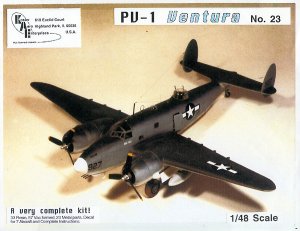Koster Aero Enterprises 1/48 PV-1 Ventura | | Background The early success of Lockheed 'Hudsons' in British service induced Lockheed to design a more advanced version. With a coat of drab paint, the addition of defensive armament and a bomb bay, the Lockheed Model 18 'Lodestar' commercial airliner became that aircraft, the B-34/PV-1 Ventura. The RAF liked what they saw, and placed an order for 675 airplanes. Development and testing went smoothly, and a little more than a year after the type's first flight on July 31, 1941, the first production machines entered service with the RAF's No. 21 Squadron. Designated Ventura 1, the new airplane was bigger and deeper than the Hudson, with more powerful engines, increased payload capacity, and more defensive armament. Bomber Command initially operated the type, but they did not fare well as daylight bombers. The aircraft on hand were all transferred to Coastal Command for maritime patrol duties, and the bulk of the British order cancelled. The rest of the order was instead diverted to the Army Air Corps, entering service as the B-34 'Lexington' and being used also for maritime patrol and navigation trainers. An upgraded version was ordered for the Army, designated B-37, but the bulk of this order was cancelled as well. The two cancellations would suggest that no one wanted Lockheed's Model 37, but that was far from the case. The US Navy requisitioned a batch of the Lend-Lease B-34s enroute to Britain, and following the cancellation of British and USAAF orders, all production was transferred to the Navy. Eventually, 1600 or so PV-1s were built for the US Navy, including nearly 400 that were provided to the UK, the majority of which served with Commonwealth air arms. In 1943, the Navy ordered an improved version with longer range, more powerful engines, and heavier armament. Four hundred seventy of these PV-2 'Harpoon' machines would see service, primarily in the Pacific. The last ones did not leave the Navy Reserves until several years after the war. The Kit Bill Koster has been producing vacuformed kits and conversions for some time now - and is something of a legend among die-hard prop fans. I had seen a review in FSM about his PV-1 kit when it first came out a few years ago, but it wasn't until I found out he lives 20 minutes away from me that I finally was able to procure one. 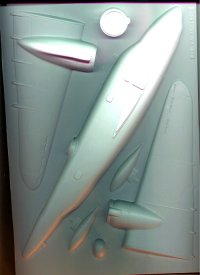 Inside the very sturdy box are three sheets of vacuformed white styrene, one of clear, a bag of resin parts, a bag of white metal parts, decals and instructions. There are sufficient parts included to build pretty much any PV-1 variant, including the one-off, experimental night fighter with the gun nose. Inside the very sturdy box are three sheets of vacuformed white styrene, one of clear, a bag of resin parts, a bag of white metal parts, decals and instructions. There are sufficient parts included to build pretty much any PV-1 variant, including the one-off, experimental night fighter with the gun nose.
The vacuformed parts are made by Bill himself on a table in his basement. They are crisp and clean, with very good detail. Panel lines are scribed, and are (for the most part) fine, though a few will need to be cleaned up. The styrene is 40 thou - thick enough to stand up to normal handling, and strong enough 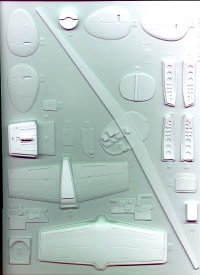 to keep the shapes. Included on the white sheets are fuselage halves, wings and stabilizers, engine nacelles, and various internal bulkheads and flooring. The clear parts provide the canopy and fuselage windows, plus separate turrets for Commonwealth and US aircraft as well. Control surfaces are molded in the neutral position, and it appears they would be a challenge to separate and repose. About the only choice you get for positionable surfaces is the crew access hatch (and the gun turrets, of course). One neat feature is the large spar and bulkhead that will not only make a strong join possible between wing and fuselage, but will enable one to get the right dihedral as well. Many modelers reinforce vac models with internal bulkheads or expanding foam; Bill told me he doesn't find that necessary with his kits, as the parts provided do a good enough job (and the models in his display case attest to that). to keep the shapes. Included on the white sheets are fuselage halves, wings and stabilizers, engine nacelles, and various internal bulkheads and flooring. The clear parts provide the canopy and fuselage windows, plus separate turrets for Commonwealth and US aircraft as well. Control surfaces are molded in the neutral position, and it appears they would be a challenge to separate and repose. About the only choice you get for positionable surfaces is the crew access hatch (and the gun turrets, of course). One neat feature is the large spar and bulkhead that will not only make a strong join possible between wing and fuselage, but will enable one to get the right dihedral as well. Many modelers reinforce vac models with internal bulkheads or expanding foam; Bill told me he doesn't find that necessary with his kits, as the parts provided do a good enough job (and the models in his display case attest to that). 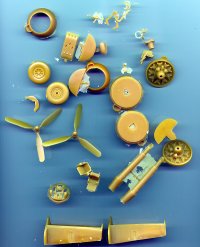 The resin bits are cast in a smelly tan poly-urethane resin, reminiscent of Collect-Aire's offerings (in fact, I think that's who does Koster's casting). These provide seats and other interior bits, wheels, antennae, engine fronts, and other details. There is a bit of flash that will need to be cleaned up, but otherwise the moldings look defect-free. The resin is hard and somewhat brittle, so care will be needed when handling the parts. The resin bits are cast in a smelly tan poly-urethane resin, reminiscent of Collect-Aire's offerings (in fact, I think that's who does Koster's casting). These provide seats and other interior bits, wheels, antennae, engine fronts, and other details. There is a bit of flash that will need to be cleaned up, but otherwise the moldings look defect-free. The resin is hard and somewhat brittle, so care will be needed when handling the parts.
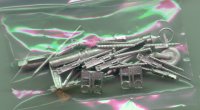 The white metal parts provide machine guns and landing gear struts. These casts are also sharp and clean, and free of major defects. The white metal parts provide machine guns and landing gear struts. These casts are also sharp and clean, and free of major defects.
Decals, printed by Microscale, are provided for five machines, a mix of USN and RAF aircraft. They are sharp and perfectly registered. Just what one would expect of Microscale, in other words. 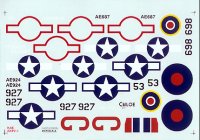 Instructions consist of one sheet, front and back. They are a series of diagrams walking the builder through assembly. They are clear and appear concise - I guess we'll see how helpful they are when I build this beast! The painting/marking guide consists of just five small side profiles with color notes. There don't appear to be any color notes for the interior or detail painting, however. Instructions consist of one sheet, front and back. They are a series of diagrams walking the builder through assembly. They are clear and appear concise - I guess we'll see how helpful they are when I build this beast! The painting/marking guide consists of just five small side profiles with color notes. There don't appear to be any color notes for the interior or detail painting, however.
Conclusions It's been a long time since I built a vacuform kit - and this one might just be what I need to get back into it. I doubt it will be any more difficult (or frustrating) than the limited run injection molded and resin kits I have been building of late. The subject matter is unique, and if you have the interest, patience, and intermediate modeling skills, I'd recommend this model. You certainly won't see a better kit of this subject in this scale any time soon! 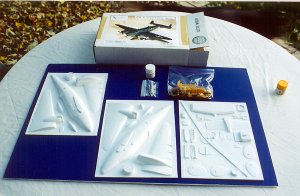
| 









    |
